The following story is an accumulated experience of now over six months of riding on the Framed Alaskan Carbon X1. The purpose of this extended test ride was to formulate a ride experience in both seasons. The red dirt of summer, the white snow of winter. All riding was conducted on Cuyuna’s summer dirt and winter groomed single track. Photographs were captured throughout the test rides, others were photographed at the completion of the test ride. Sit back, relax, here’s the story.
I took delivery of the Alaskan Carbon X1 as fall had arrived. The bike was equipped at this time fairly close to stock save the shorter RaceFace stem and RaceFace carbon bars. Earlier this summer (2014) I had the opportunity to test a prototype of this bike at Cuyuna, and I was excited to start a now much longer assessment of where the Alaskan stacks up.
The first big mention this bike receives is the Rockshox Bluto suspension fork. Yes, I realize this isn’t a Framed exclusive component, but, this fork is a wonderful asset to a fat-bike in my opinion. I’ve been riding fat-bikes sans suspension and loving it, however, in the summer, riding with front suspension is a real treat, especially when building speed on the downhill.
As I mentioned above, the time of delivery of this bike was fall, which places us in the time of year for night rides. In Cuyuna, we love our night rides just as much as our day rides. What surprised me right out of the gates on the Framed Alaskan is that I immediately broke a few of my personal best times at night. Why? I give the nod to Bluto and fat tires. As I mentioned in my story regarding the Salsa Bucksaw, the added width of tire and the added suspension goes a long way to providing a perception of safety. And that perception allows the rider (myself in this case) the ability to push oneself harder than normal. Notice I did say “perception.”
As a special note those “personal best” times were on downhill segments. More on that later.
During the red dirt ride experience, the Alaskan Carbon X1 was equipped with Maxxis Mammoth tires. The Mammoth tires have what I would refer to a minimal tire tread. The first time out I pumped up their PSI to a normal 10psi in the back, 8psi in the front. Bad idea. Seems the Mammoth demands more air. The reason I say this is for the auto-steer that existed at this psi. If I left my hands lightly on the bars, the tires would change directions and head where they pleased. Not ideal. I learned that if I pumped up to over 15psi in both tires, the auto-steer went away and I didn’t lose traction which is just fine by me. Sure, the ride may have been more jarring, but remember, Bluto was on the front. (Love Bluto!)
It took a while to learn how the Mammoth handled, steering didn’t produce the results I was used to, but then adding leaning plus steering allowed the tire to rail and carve, in a very fun way. However, the Mammoth’s time to engage seems slower than other tires with a similar tread pattern in terms of tread height. (Bontrager Hodag, 45NRTH Husker Du).
It seemed like fall in Cuyuna lasted extra long this past year, but finally the white snow fell. Not much to be honest, but just enough to do what I didn’t want to do. Test the Mammoth in snow. The boys at Framed insisted. “Check it out, see what they can do.” Panic ensued. As you can see in the picture below we didn’t have a ton of snow at the time, but just enough. On the hardpack groomed single track, the Mammoth’s were excellent and fast, grippy too. However, once they went off track into the loose pack, watch out. Loose cannons would be a good definition. On the top of a berm on Bob Sled, one of Cuyuna’s downhill flow trails, I was able to (on accident) have a full blown two tire skid while throwing out a snow roost. This was not planned nor anticipated but after I didn’t fall nor die I did have a pretty big smile.
Enough about the tires, the fork, what about the bike?
Good question! Framed went on the record right away saying “The Alaskan Carbon will not be the lightest carbon fat-bike on the planet, but it will be one of the strongest.” “Ok,” I thought, strong is good for me as I weigh in at 220lbs and like to throw my weight into the bike. However, knowing carbon from my summer mountain bikes, if the carbon isn’t light, the main benefit from the material is vibration dampening. The main downside you are gaining is that you have an increased chance of fracturing your frame if for some reason you land funny on a pointy Cuyuna rock. (It happens.)
During this process I also learned that Framed went a long way to making sure their frame was strong. During conversation with their development team I learned that their team of riders tested a series of carbon frames for five months with the carbon forks and Bluto. Then Framed sent some of their preferred frames to EFBE in Germany to go through the testing gauntlet. Here’s what happened next.
First Test – The Alaskan frame passed the three core fatigue test stages of the EFBE TRI-TEST, but failed the static “single sided pedal load” maximum load test at 2,300 N. Fork passed EFBE first round.
Framed connected their factory with EFBE. Framed reports significant time and financial investment in replicating the EFBE tests in their factory so they could be confident their next tests would pass.
Second Test – The Alaskan carbon frame passed the entire EFBE TRI-TEST with some additional tests Framed had added. Rear brake mounts on fat tire bikes need to be extra strong, Framed had that test added.
This link shows the Framed frame as a ‘Top Performer’ at the bottom of the page.
http://www.efbe.de/testergebnisse/fulltest/enindex.php?typ=1&sort4
All this is to say, the Framed Alaskan Carbon can handle a rough ride as it’s now built up to a thicker layup.
From a ride assessment during the red dirt months with the Bluto installed, the Alaskan was fun. It moved, it carved, it edged similar to shaped downhill skis when leaning side to side, it plowed through the downhill chop through rocks and roots. Where I felt a lag was the rolling momentum on uphill climbs, both sustained and small rollers. The power transfer from the drive train to the rear wheel just didn’t seem up to par in comparison to the bikes I’ve tested prior.
Winter Groomed Single Track Ride Experience
When the snow finally came to Cuyuna it was time to go back to Framed in St. Paul, MN and have them swap out the summer tread of the Maxxis Mammoth and install the winter tread of the Vee Bulldozer. As an added bonus, Framed also installed their proto carbon tubeless rims along with their carbon fork. I didn’t complain.
The first ride out of the gates it was noticeable the carbon proto rims sans tubes made a difference. Rolling momentum increased, speed increased, smiling increased. The reduced weight transitioning to a carbon fork versus Bluto also helped. These first few rides the trails were hard packed (white snow concrete) as the snow wasn’t ample, and, a few walkers thought punching holes into the trail would be added fun. I cycled these sections of trail on both the Alaskan Carbon and my Trek Farley. My purpose was to compare side by side the carbon versus aluminum in regard to vibration dampening experience. In this case, in this setting, the winner was the Alaskan Carbon on the walker-induced-bumpy-groomed-single track. That’s a tip of the hat to the carbon frame, carbon fork, and the carbon wheels.

The Alaskan’s carbon fork and Framed’s Pub Hub. Pub Hub – The story behind the Pub Hub is Framed has product testers in Chamonix France. They ride a lot of the world cup tracks and like to beat up bikes. Two of them were Framed’s main product testers on this bike and run ‘The Pub’ in Chamonix. The name was a nod to tester, and let’s be honest, it just sounds good!
Bulldozer: A fitting name.
Candidly, I didn’t see eye to eye with the Vee Bulldozer. For the record, this fat-bike tire has a ton of grip, I think that’s the problem. It has too much grip. As we continued to gain packable snow on the winter trails, the rolling resistance of this tire is too high for my taste on groomed single track. The Bulldozer lived up to it’s name. It can go through a ton of snow and still track a line, but, the friction of the tire depleted my energy reserves over the course of a two-hour ride on groomed single track. Take this as this testers results and YMMV.
As a sidebar, the first time I saw the Bulldozer in person I really liked the micro grid pattern that is created on the actual surface of the tire. However, after riding this tire on multiple snow surfaces (See photo below) that grid has the ability to keep snow on the tire. More snow = more weight = more friction = less smiling.
Throughout the remainder of my winter rides, I started to witness a pattern. I started off leading the group, I took off like a typical bat-out-of-hell, but I’d start to loose energy quicker than normal, and eventually, I’d be behind my fellow riders by quite a bit due to being “pooped out” for lack of a better phrase. During this same time I rode with the same cyclists on the same trails on other fat-bikes and didn’t experience this phenomenon.
This storyline should not be held against the Alaskan Carbon X1 however, it’s a tire, and there are so many different tires a cyclist can pick from. I’d highly encourage Framed to provide additional winter tread options for their Alaskan Carbon lineup to improve the winter ride experience. In conversation with Framed, they also have their own tire, the Minnesota, however, I have no time on this tire so I cannot rate it’s winter snow performance at this time. Here’s a link to a review on the Minnesota fat-bike tire on this website.
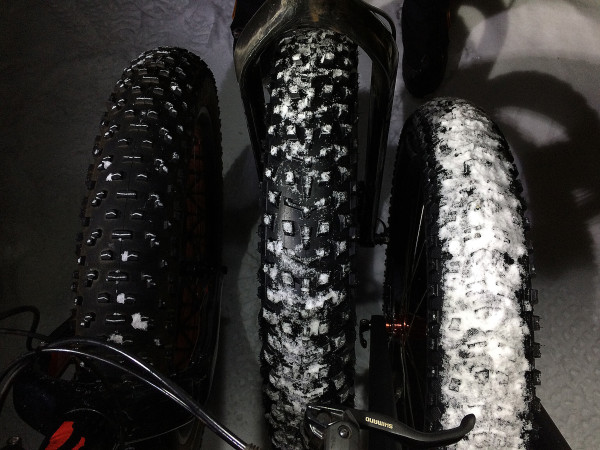
Left: Specialized Ground Control Fat — Center: 45NRTH Dillinger 4 — Right: Vee Bulldozer This photo was taken immediately after each of these three bikes exited a trail. Same time, same snow, same trail, different tire, huge difference.
Dropper no drop.
Another item I learned over the frozen tundra season is that the Rockshox Reverb didn’t work for me when the temps dropped below freezing. I asked Framed to install the dropper post on the Alaskan Carbon as I wanted to take hold of our flow country downhills, but, it froze up on each and every ride. Bummer dude. Noted for future reference.
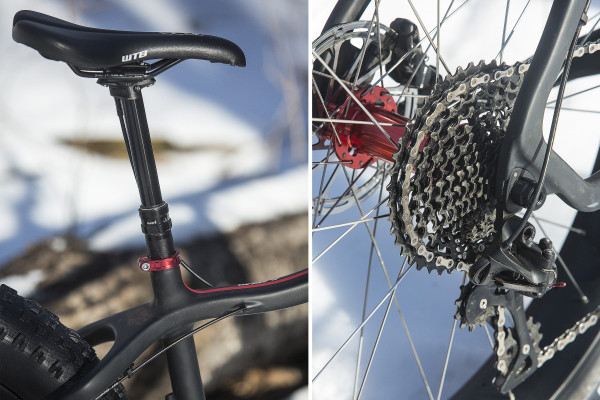 As always, the SRAM 1×11 is a wonderful drive train. I enjoy what it can do and how it simplifies my ride experience of only having two levers to think about when shifting. Framed provides a ton of value in providing the 1×11 drive train to their Alaskan Carbon offering. I would highly recommend this set-up.
As always, the SRAM 1×11 is a wonderful drive train. I enjoy what it can do and how it simplifies my ride experience of only having two levers to think about when shifting. Framed provides a ton of value in providing the 1×11 drive train to their Alaskan Carbon offering. I would highly recommend this set-up.
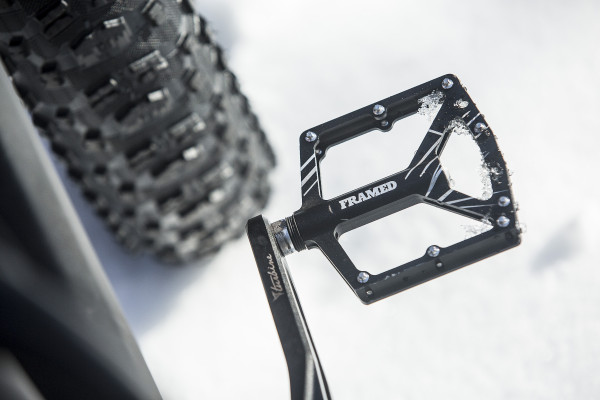 Framed also forged their own pedals for the Alaskan. Shown above is their winter specific pedal allowing a big boot to grip it and rip it. From a personal riding experience, this pedal connected well with the my 45NRTH Wolvhammer, no slip, just connection, I like that.
Framed also forged their own pedals for the Alaskan. Shown above is their winter specific pedal allowing a big boot to grip it and rip it. From a personal riding experience, this pedal connected well with the my 45NRTH Wolvhammer, no slip, just connection, I like that.
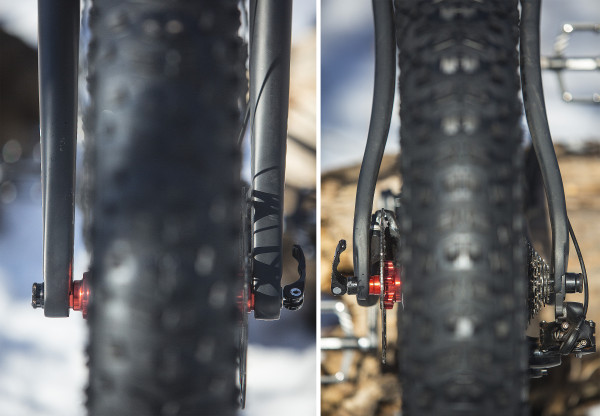 The only other “new-to-me” item I saw on the Alaskan Carbon was the quick release within the front and rear axles. As shown in the photo above you’ll see the quick release locks into a nut that sits outside of the actual front fork and the rear frame. I am accustomed to having the actual locking mechanism right within the fork or frame. You’d have to be an engineer to know if this affects the ride, or the stiffness of the ride, but for the purposes of this ride review I wanted to point this out as a design that was new to me.
The only other “new-to-me” item I saw on the Alaskan Carbon was the quick release within the front and rear axles. As shown in the photo above you’ll see the quick release locks into a nut that sits outside of the actual front fork and the rear frame. I am accustomed to having the actual locking mechanism right within the fork or frame. You’d have to be an engineer to know if this affects the ride, or the stiffness of the ride, but for the purposes of this ride review I wanted to point this out as a design that was new to me.
 Above you see how the quick release skewer actually goes through the frame and locks into the nut that rests outside of the frame.
Above you see how the quick release skewer actually goes through the frame and locks into the nut that rests outside of the frame.
Framed Alaskan Carbon X1 411:
• Max rider weight: 250 lbs
• Framed 3.0 Rim Width: 80mm
• Framed Proto Carbon Rim, Single Wall Width: 80mm
• Framed Proto Carbon Rim, Single Wall Max Rider Weight: 250 lbs
• Max Tire Width Clearance: 4.8″ – Although Framed mentioned the front and rear will take a tire up to 5″.
• Total Weight of the Framed Carbon Alaskan X1 with Proto Single Wall Carbon Rims and Carbon Bars: 28.27 lbs
 Conclusion: Buying Advice.
Conclusion: Buying Advice.
Per the Framed website, the Alaskan Carbon X1 I tested, minus the Carbon wheels and handlebars retails for $2,949.95.
If you wanted to add the carbon fork and a winter set of tires, you’d be looking at additional dollars, but it is an option you have on the table.
At the price point of $2,949.95, carbon fat-bikes with Bluto in a similar price point are:
• I still haven’t found one.
At the same price point noted above, aluminum fat-bikes with Bluto in a similar price point are:
• Trek Farley 8 ($3,149.99)
• Rocky Mountain Blizzard ($2,699.00)
So the question you have to ask yourself is, how important is carbon to you?
Framed has well established the Alaskan Carbon is not lighter, but it does like it rough!
Do you ride for speed? Ultra-light, ultra-quick?
Most likely the Alaskan Carbon is not for you.
Do you ride like a bull through a china shop?
Do you break bikes? Do you find unending ways to punish a bike in new and interesting ways?
The Alaskan Carbon might be right for you.
Chew on it, take some time, you’ll know what to do.
In closing.
Kudos to Framed for goosing the system in the fat-bike industry. They may have a different vision than some of their fat-bike industry peers, but they are getting people on fat-bikes, and more people cycling is what the fat-bike is all about!
Cheers to a Minnesota company.


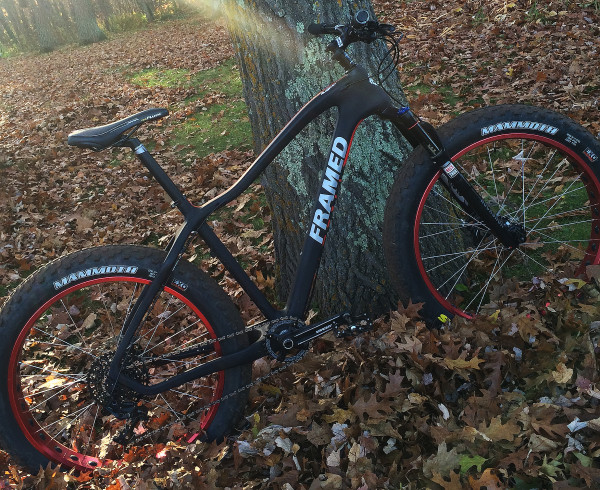
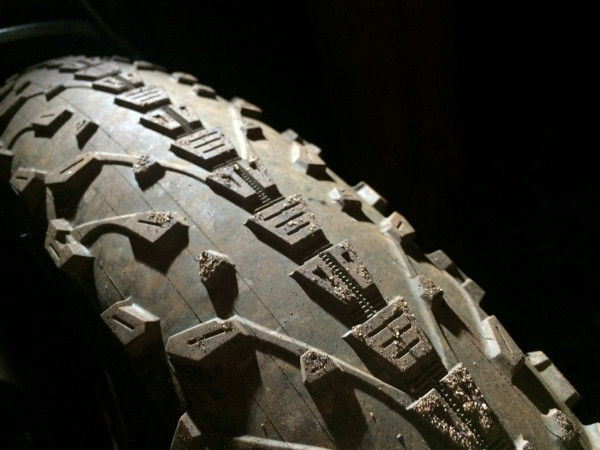
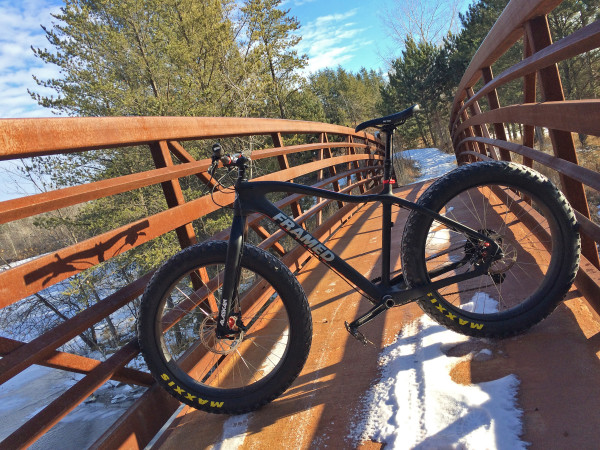
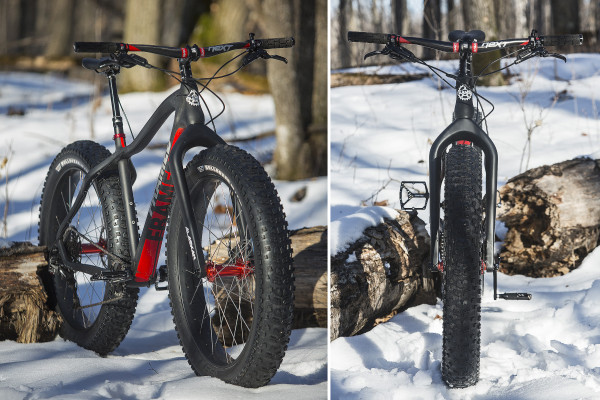
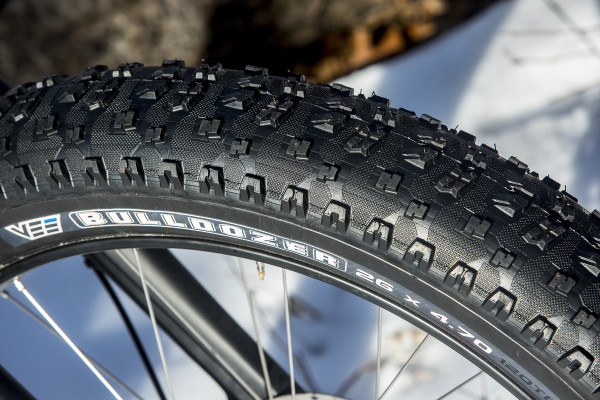
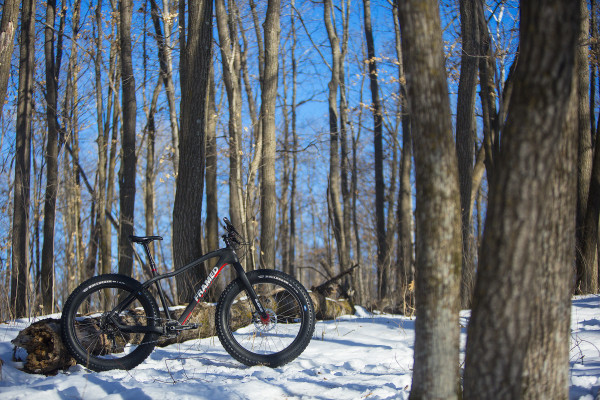
Looks like a GTG option. I know gomez had issues with auto steer with the mammoths that were mounted on his fatback he rode one night when he was up north. If pressure solves this I think it might be a good tire for summer. I am not sure what I will run this summer. My nates were stolen out of the back of my truck. I am thinking good old HUdu might be the best bet still but I am anxious to see other tire test before the ice is gone here and I have to pull my D5’s.
Besides this being a difficult read, you lost me when you put 10psi in a strictly dirt tire for riding on dirt and then say the bike does not sustain it’s roll and is slow. I feel like I read a review about tires vs the bike its self.
Same thoughts as Mr. I know everything (March 25), where I am walking away thinking it was a tire review. I have this bike and so far I am impressed with the frame’s stiffness. It climbs great and love the X1 drivetrain. I have swapped the mechanical brakes for avid trail XO and put on a cane creek thudbuster. Changed stem/bar for a Straitline AMP and Spank Oozy, so it looks good. I would like to have an “addendum” addressing the authors thoughts on geometry and more details regarding frame performance. One side note/question deals with the expected TP for fat tires. Is the perception regarding 5-10 psi for fat tires exited stage left yet? I am 210 lbs and run 15-20 psi, where lighter guys are moving up in psi. also. I believe that the high pressure and associated bounce that has spooked folks to believe they need to run low psi is fading. The feel and ride of a fat bike can’t be compared to normal mnt bike wheels/tires, since so many factors in the rider’s response to the ride and handling are developed overtime. I have started to use that energy transfer in my climbing and turns (steering) in ways that make me feel like a kid again. This is my second fat bike and I was so exited to see that bike shops in Moab (poison spider) are renting them and friends out there are all over fat bikes, so cool. Fat bikes have been that rare advancement in a sport that breathes new life into the sport. Thank you to the pioneers out there!!! Jonathan White